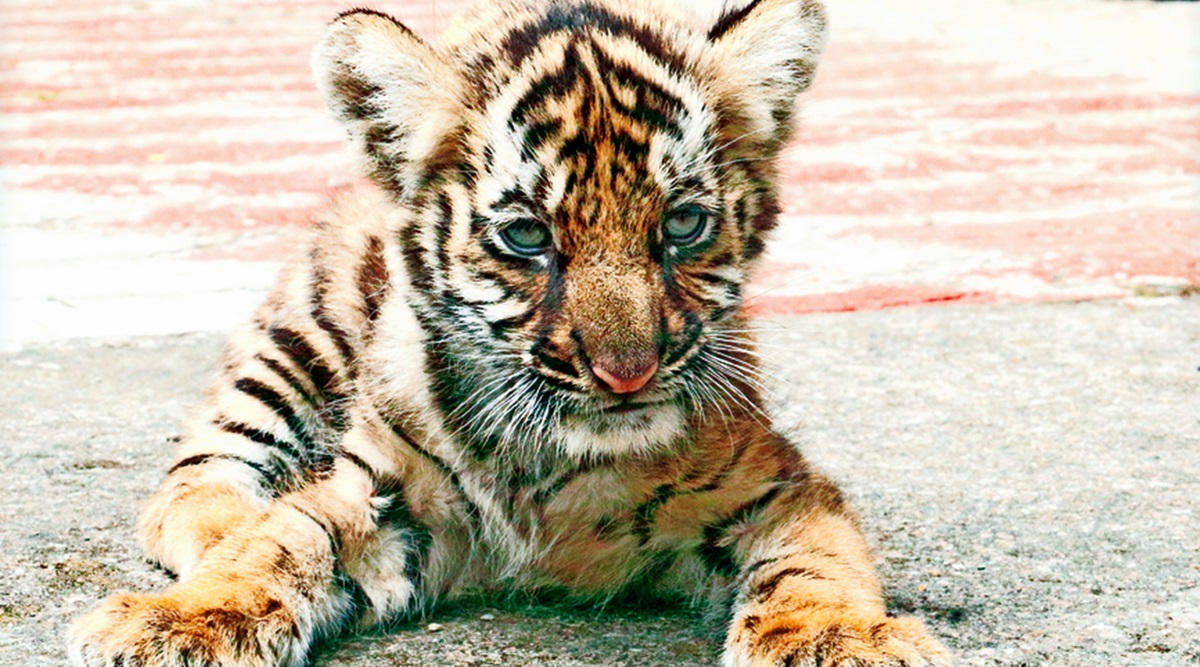 Mangala is being ‘rewilded’ at the Periyar reserve. (Express photo)
Mangala is being ‘rewilded’ at the Periyar reserve. (Express photo) Last year, she was found abandoned near a temple in Idukki — frail, her eyes cloudy, and with a bad limb. But now, under the watchful eyes of officials of Kerala’s Periyar Tiger Reserve (PTR), the nine-month-old tiger cub is being taught a key survival skill: hunting in the wild.
The cub, named Mangala by PTR staff, is undergoing a rewilding process as part of which she will be taught hunting skills over the next two years before being released into the wild. PTR, spread over 777 sq km, has about 40 tigers.
PTR Deputy Director Sunil Babu told The Indian Express, “Rewilding is a long, costly process. For the last seven months, the cub has been in a small 500-sq-ft enclosure and is being fed by handlers. Within a few days, she will be taken to a larger enclosure of one hectare, erected in the core area of PTR, where she will learn her hunting skills for the first time. Later, the enclosure will be gradually widened to 40 hectares. Hunting skills are crucial for the tiger’s survival in the wild. We hope that within two years, before she is released, she will gain enough exposure in hunting down prey,’’ he said, adding that tiger cubs usually start to hunt independently when they are around two.
On November 21 last year, the cub, barely two months old, was found near the Mangala Devi temple within the reserve, possibly abandoned by her mother, say park officials. They put up camera traps in the region and waited for a few days, hoping the mother would come to take back her stranded cub. But she did not come, and the park officials took the cub in.
Babu says that when they found her, both her eyes were cloudy and she was dragging her hind limb. But under the care of the PTR staff, she is now in good shape. From 3 kg seven months ago, the cub now weighs a healthy 30-35 kg, thanks to a diet of meat and imported goat milk powder.
On possible reasons for the cub being abandoned, the PTR Deputy Director said, “It is possible that the mother died and the cub was orphaned. Another possibility is that the mother abandoned her cub because she had deformities. The rescued cub had issues with her eyes and leg, and tigers have a habit of abandoning such cubs.’’
While her traumatic past is behind her, another challenge awaits the cub: she needs to learn to hunt, a key factor in the rewilding process.
“In the next stage of rewilding, human interaction will be reduced to almost nil. In the larger enclosure, the animal will be monitored using surveillance cameras. When we expand the size of the fenced area, she will be allowed to hunt down prey. Initially, we will have to drop domestic animals such as goats. But feeding the tiger domestic animals is also a risk as that might create a tendency for the tiger to foray into human settlements. Once she is in the larger enclosure, we will put up gates to send in animals that tigers usually prey on.’’
Anu Raj, a veterinarian at PTR, said the park is following the re-wilding protocol laid down by the National Tiger Conservation Authority (NTCA).
He added the animal has increasingly been aloof towards her handlers, an encouraging “sign of its wild nature”.
In a similar case in Maharashtra, in March this year, a three-year-old tigress, PTRF_84, was released into the jungles of the Pench Tiger Reserve after two years of a rewilding programme. The tigeress was about a year old when her maneater mother T1, nicknamed Avni, was shot dead in Pandharkawada forests of Yavatmal in Maharashtra. PTRF_84, one of Avni’s two cubs, was captured and released into the wild after the rewilding programme. The experiment had, however, ended badly, with PTRF_84 dying of injuries sustained during a territorial clash in the jungle, merely eight days later.
- The Indian Express website has been rated GREEN for its credibility and trustworthiness by Newsguard, a global service that rates news sources for their journalistic standards.

